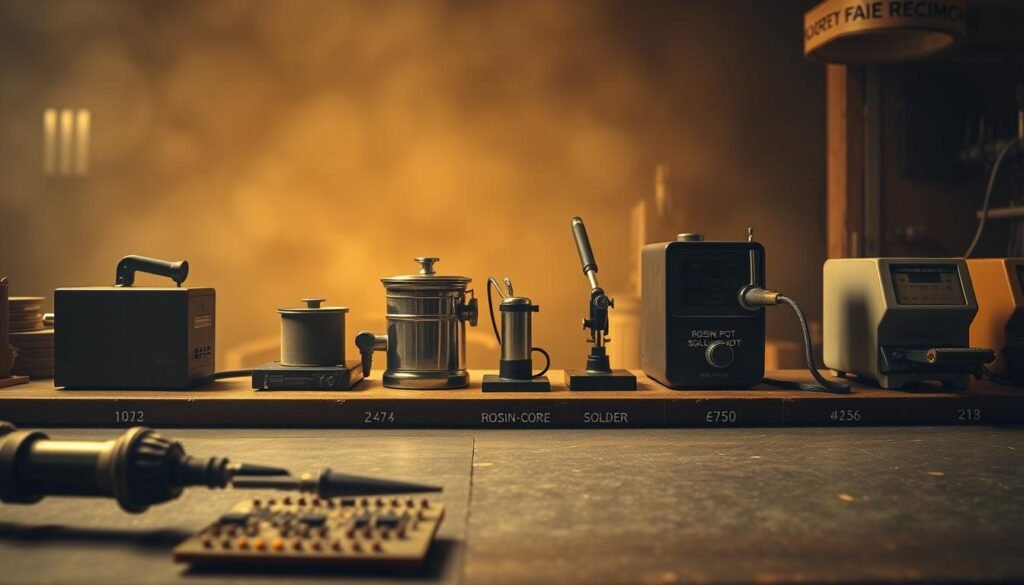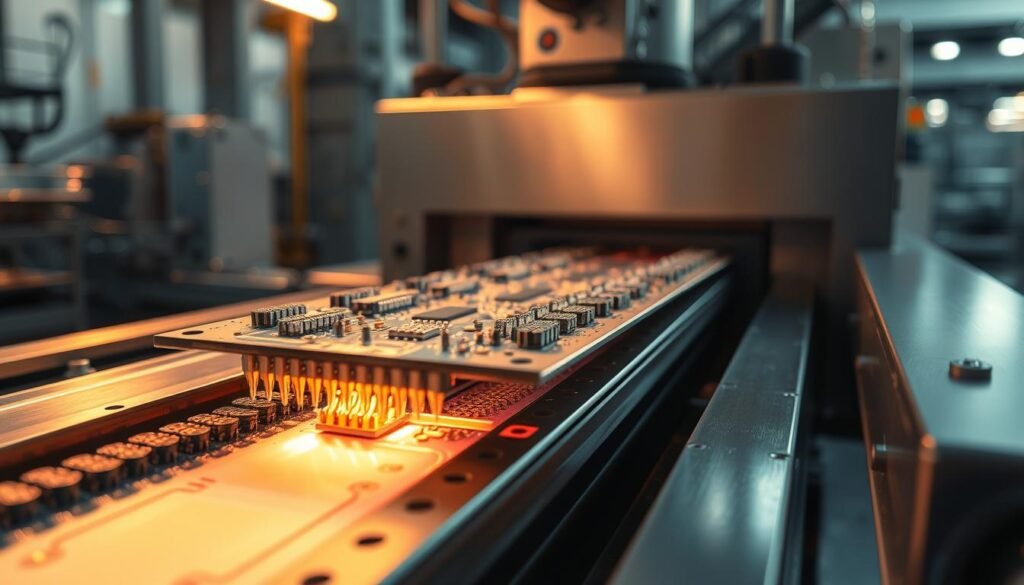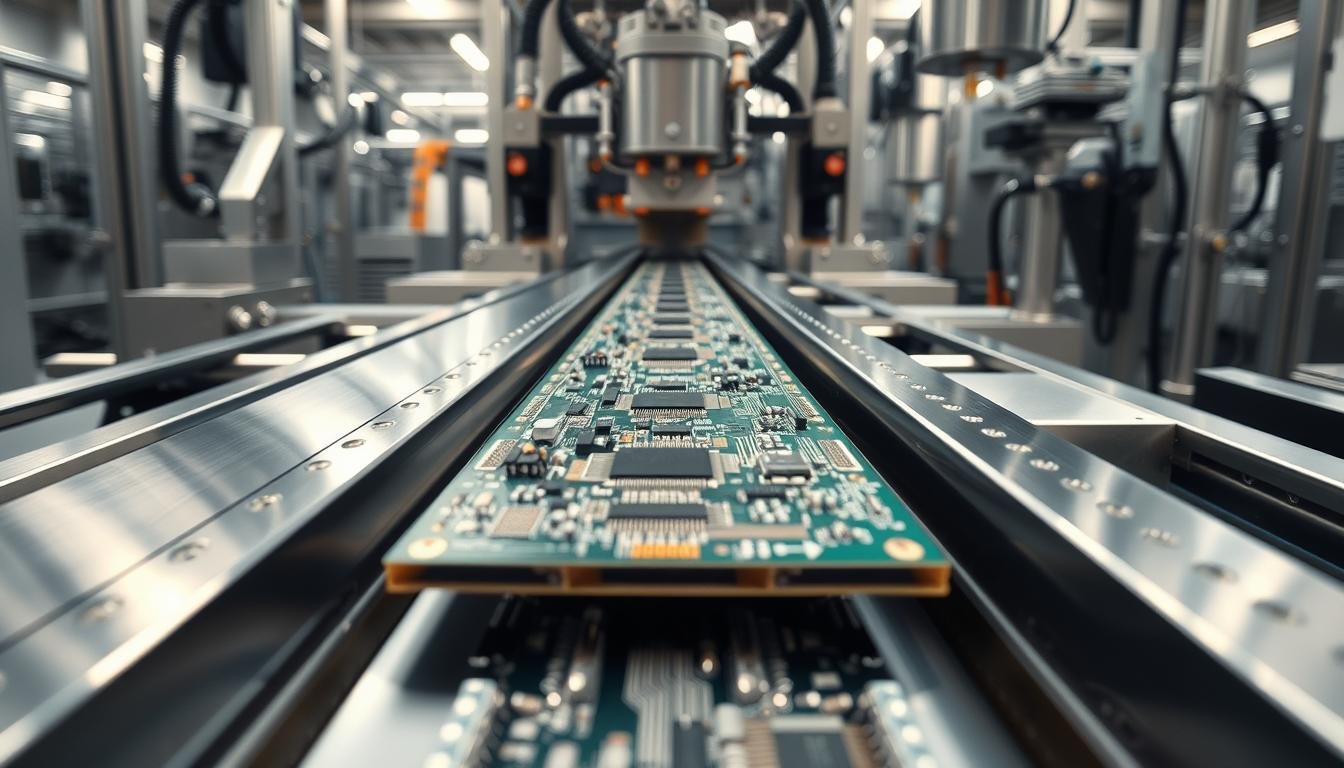Imagine building complex circuits by hand in an era before smartphones or laptops. How did we transition from painstaking manual assembly to producing billions of reliable devices annually? The answer lies in a groundbreaking technique that reshaped modern industry.
This method emerged as the first practical solution for mass-producing electronic assemblies. By passing circuit boards over precisely controlled molten material, manufacturers achieved unprecedented speed and consistency. The process eliminated human error while creating durable connections that withstand mechanical stress and high currents.
We’ll explore how this technology works at molecular levels – from flux activation to thermal dynamics. You’ll discover why it remains indispensable for applications demanding robust physical bonds, even as surface-mount technology advances. Our analysis covers historical context, operational principles, and quality control measures that ensure compliance with military and industrial standards.
Key Takeaways
- Automated connection method replaced century-old manual techniques
- Ensures consistent joint quality across high-volume production
- Critical for durable assemblies in harsh environments
- Combines fluid dynamics with metallurgical science
- Maintains relevance despite new component technologies
Introduction to Wave Soldering and Through-Hole Components
In an industry where reliability is non-negotiable, through-hole components anchor critical connections. These parts feature leads that penetrate entirely through PCB layers, creating bonds that surface-mount devices can’t replicate. Their design provides unmatched mechanical stability – a necessity for industrial machinery and aerospace systems.
Unlike surface-mounted alternatives, through-hole parts excel in high-current scenarios. Their extended leads form joints that withstand vibration and thermal stress. “You can’t achieve this durability with surface-mount alone,” notes a senior process engineer at a leading defense contractor.
Automated systems revolutionized how we handle these components. By moving boards across a precisely controlled molten material stream, manufacturers solder hundreds of joints in seconds. This approach eliminates inconsistencies found in manual methods while accommodating larger connectors and power regulators.
Three factors make this pairing indispensable:
- Lead geometry ensures optimal contact with molten material
- Through-board penetration creates interlocking mechanical bonds
- Automation scales production without sacrificing joint integrity
From medical devices to renewable energy systems, this combination remains vital where failure isn’t an option. While newer technologies emerge, some applications still demand the proven resilience of through-hole assemblies.
Historical Evolution of Soldering Techniques

The journey from glowing vacuum tubes to modern circuit boards reveals manufacturing’s relentless pursuit of precision. Early 20th-century electronics relied on hand-soldered wires connecting bulky components – a process slower than watchmaking. Each connection demanded individual attention, limiting production to dozens of units daily.
From Hand Soldering to Automated Methods
World War II accelerated innovation when proximity fuses required rapid assembly. Engineers developed flow techniques where boards passed over molten material streams. These military prototypes achieved 300% faster production than manual methods.
Post-war electronics faced new challenges. Single-sided PCBs emerged in the 1950s, but early dip methods failed spectacularly. Factories discovered boards placed directly on solder pools suffered from:
| Method | Era | Key Features | Defect Rate |
|---|---|---|---|
| Hand Soldering | 1900-1940s | Individual joints | 12% |
| Dip Soldering | 1950-1955 | Full immersion | 38% |
| Drag Soldering | 1955-1960 | Conveyor movement | 19% |
The Transition from Dip to Drag Soldering
Manufacturers quickly abandoned dip approaches after boards warped like potato chips in hot oil. Drag systems introduced conveyors but created new headaches. Boards sagged under heat, trapping corrosive flux between layers.
A 1957 industry report noted: “We’re trading one set of defects for another.” These growing pains ultimately paved the way for controlled wave techniques. Each failed experiment brought engineers closer to solutions balancing speed with reliability.
Military declassification in 1948 proved pivotal. Flow concepts from fuse production merged with consumer electronics needs, setting the stage for today’s high-volume manufacturing. What began as artillery technology now powers your smartphone’s assembly.
Wave Soldering for Through-Hole Components: How it Works

Modern electronics manufacturing relies on precision processes that ensure durability and efficiency. Our team breaks down the sequence creating reliable bonds between parts and boards.
The automated sequence begins with prepped boards moving on conveyors. Components with extended metal legs sit firmly in drilled holes. As assemblies enter the soldering zone, three critical phases activate:
- Flux sprays remove oxides from metal surfaces
- Preheating stabilizes board temperatures
- Molten material flows upward through nozzles
Special pumps generate a smooth, standing ridge of liquid alloy. This “quiet wave” flows evenly across the board’s underside. Component legs interact with the moving material through capillary action – the same physics that draws water up paper towels.
Optimal results require exact conveyor speeds (typically 1-2 meters/minute). Too fast, and connections become brittle. Too slow, and heat damages sensitive parts. Advanced systems monitor thermal profiles in real-time, adjusting variables as needed.
Post-contact cooling solidifies joints within seconds. Properly formed connections exhibit concave fillets wrapping each lead. Defects like bridges or voids become rare when parameters align with board specifications.
| Parameter | Typical Range | Impact |
|---|---|---|
| Conveyor Speed | 1.2-1.8 m/min | Contact duration |
| Solder Temp | 250-265°C | Flow characteristics |
| Wave Height | 8-12mm | Coverage depth |
Through this orchestrated interplay of mechanics and metallurgy, manufacturers achieve near-perfect joint formation across entire production runs. The method’s repeatability explains its enduring relevance in critical applications.
The Molten Solder Wave Process Explained
Precision in electronics assembly hinges on controlled material interactions. Our team breaks down the four-stage sequence that transforms raw boards into robust circuit assemblies.
Flux Application and Preheating Steps
Surface preparation begins with flux application. This chemical agent removes oxides from metal contacts, creating ideal conditions for solder adhesion. Two primary methods dominate modern production lines:
| Method | Coverage | Speed | Best For |
|---|---|---|---|
| Spray Fluxing | Fine mist (95% uniformity) | High-speed lines | Complex PCB designs |
| Foam Fluxing | Bubble-generated layer | Moderate pace | Large component spacing |
Preheating follows flux application, gradually raising board temperatures to 100-150°C. This critical phase:
- Activates flux chemistry for oxide removal
- Reduces thermal shock during wave soldering contact
- Prevents moisture-induced defects
Solder Wave Contact and Cooling Dynamics
Boards then meet the molten alloy wave at 250-260°C. The standing liquid ridge flows through component leads via capillary action. Key parameters determine joint quality:
| Factor | Optimal Range | Effect |
|---|---|---|
| Contact Time | 3-5 seconds | Complete hole fill |
| Cooling Rate | 2-4°C/second | Stress-free solidification |
Post-contact cooling locks metallic bonds in place. Rapid cooling creates brittle joints, while slow rates risk component damage. Advanced systems use forced air or gradual ambient cooling for perfect microstructure formation.
Key Forces and Heat Management in Soldering
Behind every reliable circuit board lies invisible physics governing material behavior. We decode the molecular interactions and temperature strategies that transform liquid alloys into solid bonds.
Surface Tension and Interatomic Attraction
Surface tension acts as nature’s quality inspector during soldering. This force pulls excess material back into the wave, preventing bridged connections between component legs. When metals oxidize, surface tension drops by up to 40%, creating icicle-like defects that appear solid despite containing liquid solder.
Interatomic attraction drives the bonding process. Pure metal surfaces allow solder to spread through capillary action, forming concave fillets. Our tests show contaminated surfaces repel solder completely – a key reason flux chemistry remains critical. Properly prepared surfaces achieve:
- Wetting angles below 35° for optimal coverage
- Intermetallic layers 2-5µm thick
- Electrical resistance under 0.5mΩ per joint
Effective Thermal Profile Control
Heat management separates functional boards from scrap piles. Modern systems use infrared preheaters and convection zones to gradually raise PCB temperatures. Heavy components require thermal profile guidelines specifying:
| Parameter | Standard Range | Critical Impact |
|---|---|---|
| Preheat Rate | 1.5-3°C/sec | Flux activation |
| Peak Temp | 110-130°C | Moisture removal |
| Wave Contact | 245-260°C | Alloy flow |
Top-side heaters combat thermal mass challenges in power electronics. Without them, large capacitors act like heat sinks – cooling joints before proper formation. Our monitoring systems track 18 temperature zones, adjusting outputs every 0.8 seconds for perfect metallurgical results.
PCB Design and Component Layout for Optimal Soldering
Component placement determines success long before production begins. Strategic alignment prevents common defects that plague electronic assemblies. We’ve optimized layouts for thousands of boards, discovering patterns that ensure consistent results across manufacturing runs.
Smart Orientation Prevents Costly Defects
Angled placement solves the elastic membrane challenge. When parts align parallel to the material flow, liquid alloy stretches between adjacent leads like cling wrap. This tension often snaps mid-process, creating bridges that short-circuit operations.
Rotating components 90° changes everything. Each lead exits the liquid sequentially, allowing controlled drainage. For multi-sided parts like quad packs, a 45° rotation balances coverage across all connections. Our thermal imaging shows this orientation reduces thermal stress by 18% compared to standard placements.
Non-functional “solder thief” pads offer extra protection. Positioned at trailing edges, these sacrificial elements absorb excess material that might otherwise bridge gaps. They’re particularly effective for high-density boards with tight lead spacing.
Three rules govern reliable layouts:
- Perpendicular alignment to material flow direction
- 45° rotation for components with leads on four sides
- Strategic placement of drainage pads in critical zones
These principles transform theoretical designs into production-ready solutions. When implemented correctly, defect rates plummet while joint integrity meets military-grade specifications. Smart planning today prevents tomorrow’s field failures.
FAQ
Why use wave soldering instead of reflow for through-hole parts?
How does flux application prevent defects in PCB assembly?
What design rules prevent bridging in high-density boards?
Can wave soldering handle mixed SMT and through-hole assemblies?
How do thermal profiles affect joint quality in production runs?
What materials work best with lead-free solder alloys?
About The Author
Elena Tang
Hi, I’m Elena Tang, founder of ESPCBA. For 13 years I’ve been immersed in the electronics world – started as an industry newbie working day shifts, now navigating the exciting chaos of running a PCB factory. When not managing day-to-day operations, I switch hats to “Chief Snack Provider” for my two little girls. Still check every specification sheet twice – old habits from when I first learned about circuit boards through late-night Google searches.
